ISSN ONLINE(2278-8875) PRINT (2320-3765)
ISSN ONLINE(2278-8875) PRINT (2320-3765)
B.Venkata siva1, B.Mahesh babu2, L. Ravi Srinivas3, S.S.Tulasiram4
|
| Related article at Pubmed, Scholar Google |
Visit for more related articles at International Journal of Advanced Research in Electrical, Electronics and Instrumentation Engineering
Power quality of the system will be affected due to the increasing use of power electronic equipment and nonlinear loads. Active power filters (APF‟s) are effective in mitigating line current harmonics and can improve the power quality. In this paper, instantaneous active and reactive power (p-q) theory is employed to generate the reference currents and PI controller is used control the dc link voltage. The application of artificial intelligence is growing fast in the area of power sectors. The artificial neural network (ANN) is considered as a new tool to design control circuitry for power-quality (PQ) devices. The main objective of this paper is the analysis and comparision of THD of the source current with different types of controllers. Here THD of source current with conventional PI controller is compared with the artificial neural network (ANN) based PI and Particle Swarm Optimization (PSO) based PI. Hysteresis Band Current Controller (HBCC) is used to generate the gate pulses of the VSI of the filter Simulations are carried out in MATLAB/SIMULINK environment using sim power system toolbox.
Keywords |
| Power Quality (PQ), Shunt Active Power Filter (SAPF), Instantaneous Active and Reactive Power (PQ) Theory, Hysteresis Band Current Controller (HBCC), Total Harmonic Distortion (THD), Artificial Intelligence (AI) , Artificial Neural Networks(ANN), Particle Swarm Optimization (PSO). |
I.INTRODUCTION |
| Existence of non linear loads such as switching converter, converter for variable speed AC drives and HVDC systems in the power system produce harmonics on load side, to say power electronic devices are sources of harmonics. These harmonics are injected into source side of the system. So we have to mitigate these harmonics on source side for maintaining stability and improving power quality of the system [4]. Shunt active power filter (SAPF) is used for this problem. Effectiveness of SAPF depends on the (i) methods used to obtain the reference currents, (ii) use of current controllerâÃâ¬ÃŸs types. In this paper reference currents are generated with the control strategy Instantaneous active and reactive power theory (PQ theory) with conventional PI controller and artificial neural network (ANN) based PI concepts and also proportional gain (Kp), proportional integral (Ki) parameters of PI controller are further optimised with new optimization technique particle swarm optimisation (PSO). Finally, the results of conventional PI controller are compared with the ANN based PI and PSO based PI techniques. Hysteresis Band Current Controller (HBCC) is used to generate switching signals for the Voltage Source Inverter. Fig.1 shows the Block diagram representation of the SAPF. |
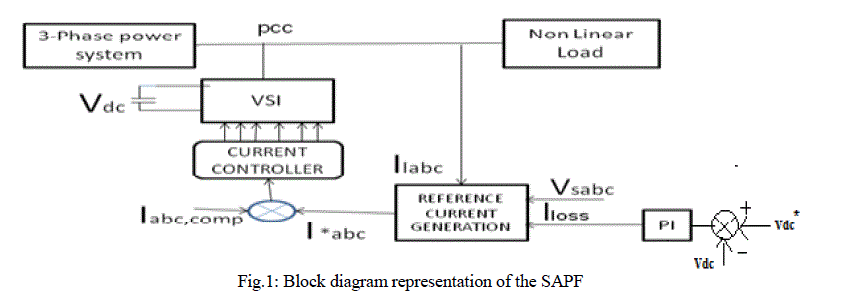 |
II.LITERATURE SURVEY |
| In past passive filters have been used for elimination of harmonics which are simple and low cost. However, the use of passive filters has many disadvantages, such as large size, tuning and risk of resonance problems. The rapid improvement in power semiconductor device technology, active power filters (APF) have been considered as an effective solution for this issue. One of the most popular active filters is Shunt Active power filter (SAPF) for mitigating current harmonics .Since the concept, " Active power filter " ,was first developed by L. Gyugyi [l] in 1970s. The control strategy for active power filter was concluded by H. Akagi [2] as three modes, load current detection, supply current detection and voltage detection, for different applications. In general the series active power filter is preferable to compensate the harmonics in supply voltage, while parallel active power filter is more suitable to compensate the harmonics in the supply current. The Active power filters (APFâÃâ¬ÃŸs) firstly developed by Akagi, provide better performances of harmonic elimination [2-5]. The (SAPF) control strategy involves not only the production of currents whether to eliminate the undesired harmonics, but also to recharge the capacitor value requested by Vdc voltage in order to ensure suitable transit of powers to supply the inverter. The storage capacitor „CâÃâ¬ÃŸ absorbs the power fluctuations by the compensation of the reactive power, harmonics and the losses of the converter for proper active power control. The average voltage across the capacitor terminals must be kept at a constant value. Generally, PI controller is used to regulate this voltage. With variation of load perturbations and non linear conditions, detecting of PI parameters is difficult and time taking process other disadvantage is inability to improve the transient response of the system. The past decade interest on Artificial Neural Networks (ANNs) is increased because of its learning ability, high speed recognition and able to adapt themselves to any system. Warren Mc Culloch and Watter Pitts [9] in1943 created a computational model for neural networks based on mathematics and algorithms, and back propagation algorithm was created by Paul Werbos [13] in 1975. Particle swarm optimization (PSO) algorithm is an optimization technique inspired by the movement of particles (birds, fishes) which is introduced by Kennedy J, Eberhart R [15] in 1995. |
III.SYSTEM CONFIGURATION |
| A 3 , 415V, 50Hz supply with non linear load as diode rectifier having RL load and Shunt Active Filter are developed in MATLAB/SIMULINK using Sim power System toolbox. |
| A. Design Parameters of Shunt Active Filter: A shunt active filter consists of three phase, three leg one for each phase, voltage source inverter. The designs for dc bus capacitor, dc bus voltage and input filter inductance are as follows |
| (i) DC Capacitor Voltage(Vdcref): |
| The reference value of the capacitor voltage Vdc ref should have at least two times boost in DC bus voltage with respect to peak of phase AC voltage at the PCC mainly on the basis of reactive power compensation capability |
 |
| (ii) DC Bus Capacitor(Cdc): |
| The energy storage capability of the DC bus of the active filter should be sufficient to sustain disturbances arising due to load perturbations. The DC bus capacitance (Vdc) of the active filter system can be computed from following equation |
 |
| Where ΔEdc is the rate energy stored in the capacitance |
| (iii) Input filter inductance(Lc): |
| The inductances used in the active power filter smoothens the ripples from the voltage source inverter. These Inductances are designed with information on the carrier signal frequency and the hysteresis bandwidth of the filter current. |
| By applying KVL at the PCC and the inverter pole point |
 |
| Where Vf is the instantaneous value of the PWM voltage at the inverter pole point and Vs is the instantaneous voltage at the PCC. |
IV.CONTROL STRATEGY |
| (A). INSTANTANEOUS REAL AND REACTIVE POWER THEORY: This control strategy is used for the generation of reference source currents [6-7]. Inputs of the Instantaneous active and reactive power theory (p–q theory) are load side harmonic currents, source voltages and loss component current from the dc link voltage control. The concept of instantaneous reactive power theory (p-q theory) method basically consists of a variable transformation from the a, b, c reference frame of the instantaneous power, voltage and current signals to the α − β reference frame [9]. The conversion formulae of voltages and currents are given below |
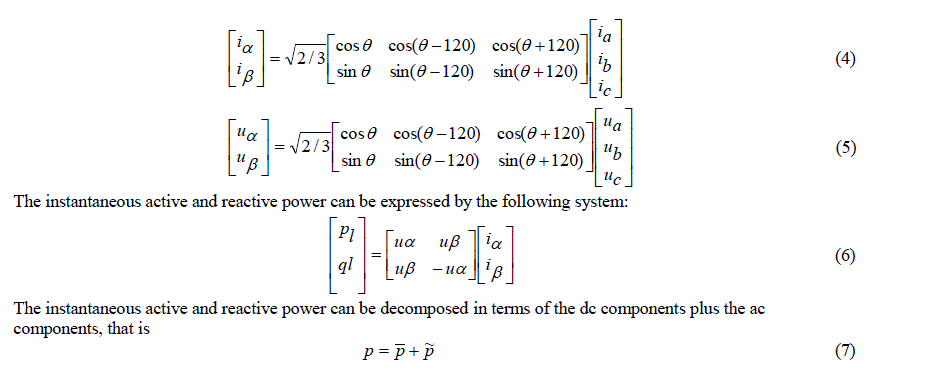 |
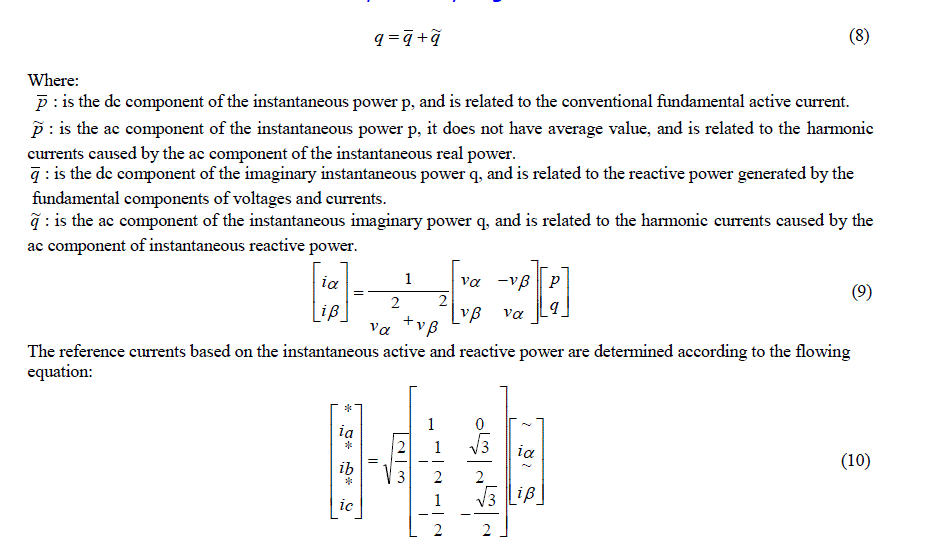 |
| The block diagram of Instantaneous Active and Reactive Power Theory (P-Q theory) is shown in Fig.2. |
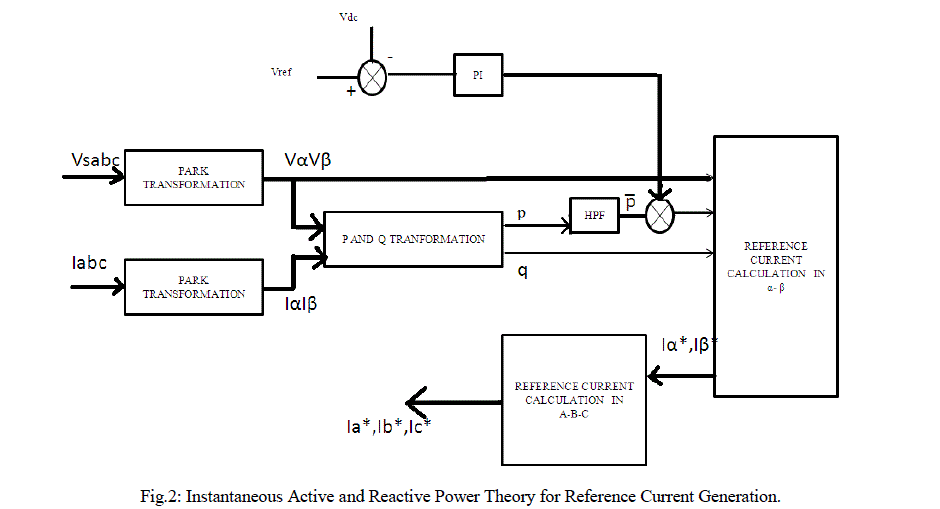 |
| (B).HYSTERESIS BAND CURRENT CONTROL: |
| Hysteresis current control technique is employed to design the control part of the APF [8] .The hysteresis band current controller for active power filter can be carried out to generate the switching pattern of the inverter. In this controller actual current is forced to track the sine reference within hysteresis band by back and forth (or bang-bang) switching of the upper and lower switches. So the inverter then becomes a current source, which is controlled within the band and makes the source current to be sinusoidal. |
 |
| The switching takes place when carrier signals crosses the error signal of iref and iact. Comparision of carrier signals |
| with the error signal of iref and iact realizes the PWM switching law described below: |
| If (iact) > (iref + hb) upper switch of a leg is ON and lower switch is OFF |
| If (iact) < (iref + hb) upper switch of a leg is OFF and lower switch is ON |
| (C). PI CONTROLLER |
| The reason behind the use of proportional integral controller is its effectiveness in the control of steady-state error of a system and also its easy implementation [6]. However, one disadvantage of this conventional compensator is its inability to improve the transient response of the system. In this circuit, the actual DC capacitor voltage is detected and compared with the reference value, and the error is amplified then added to the ilo`ss, the output of high-pass filter. |
| Therefore, active power allowed into the capacitor is being changed and the dc voltage is controlled. |
 |
| Where, (vsn ïÃâ¬ÃÂvs(n ïÃâ¬Ã 1)) is the error between the reference (Vdc*) and sensed (Vdc) dc voltage at the nth sampling instant. Kp and Ki are the proportional and the integral gains of the dc bus voltage PI controller. The placement of PI controller is shown in Fig.2 [5]. |
| (D).ARTIFICIAL INTELLIGENCE (AI) TECHNIQUES |
| Artificial intelligence (AI) is an area of computer science that emphasizes the creation of intelligent machines that work and reacts like humans. ANN (artificial neural networks) is one of the branches of AI techniques [12]. ANN is highly interconnected network of a large number of processing elements called neurons in an architecture inspired by the human brain. |
| ANN is characterised in three ways those are architecture, training algorithm and its activation function. Where Architecture is represents the connection between neurons. The feed forward neural network for single layer and multilayer are given below in fig.4. |
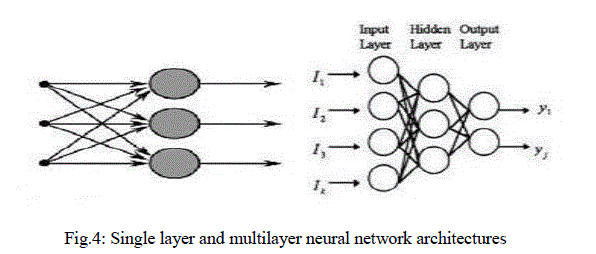 |
| And training/learning algorithm is for updation of weights and biases, in this work „Levenberg-Marquardt back propagationâÃâ¬ÃŸ algorithm is used and activation function is used for the knowing the response of neuron. For non-linear solutions and multilayer networks sigmoidal transfer function is used and for linear loads linear transfer function is used, both the functions are given below n fig.5. |
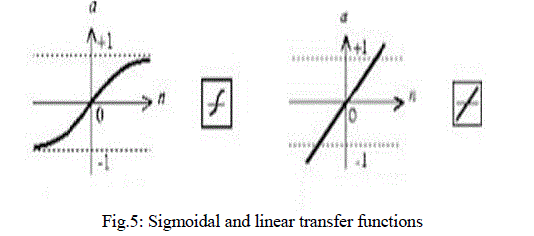 |
| The past decade has seen a dramatic increase in interest Artificial Neural Networks (ANNs) which is characterized by its learning ability and high speed recognition but simple structure, the (ANNs) have been applied in many uses in the power electronic part of both machinery and filters devices where they have justified their effectiveness. The results obtained with ANNs are often better than those of traditional methods. In this work the role of PI controller is takeover by ANN for better and fast response. It is difficult and time taking process of tuning Kp and Ki values of PI controller for varying loads but in ANN optimize simultaneously their weights and biases in an on-line training process, they are able to adapt themselves to any system [13]. The placement of ANN controller is shown in fig.6. |
 |
| In generated simulink block of neural network has three layers (input layer ,hidden layer, output layer).In layer 1 number of neurons are 2 and for layer 2 no of neurons are 21.In both layers 1&2 „tansigâÃâ¬ÃŸ transfer function is used. In layer 3 number of neurons are one and „linearâÃâ¬ÃŸ transfer function is used. ANNâÃâ¬ÃŸs PI controller is shown in fig.7. |
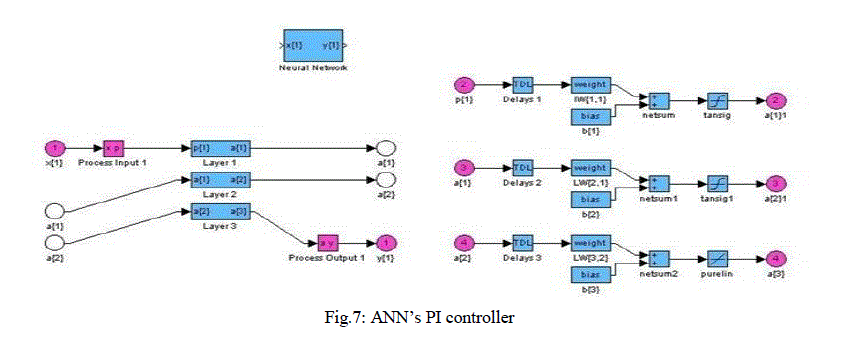 |
| (E). PARTICAL SWARM OPTIMIZATION |
| Particle swarm optimization (PSO) is a population based stochastic optimization technique inspired by social behaviour of bird flocking or fish schooling [14-15]. The moments of the birds are reflected as and we call it as moments of "particle". All particles have fitness values which are evaluated by the fitness function to be optimized, and have velocities which direct the flying of the particles. This paper employs the objective function as minimization of Total Harmonic Distortion (THD). The fitness function is defined as follow: |
| The optimization parameters are proportional gain (Kp) and integral gain (Ki), the transfer function of PI controller is defined by: |
| The gains Kp and Ki of PI controller are generated by the PSO algorithm for a given plant. As shown in Fig.8. |
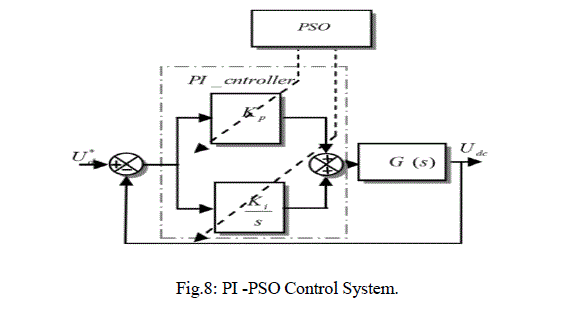 |
 |
| The position of particle move rule is shown as follows: |
 |
| where represents the velocity vector of particle s in t time; represents the position vector of particle s in t time; best is the personal best position of particle s, Gbest is the best position of the particle found at present; w represents inertia weight; c1, c2 are two acceleration constants, called cognitive and social parameters respectively; and r1 and r2 are two random functions in the range [0, 1]. The flow chart of general PSO is shown in Fig.9. |
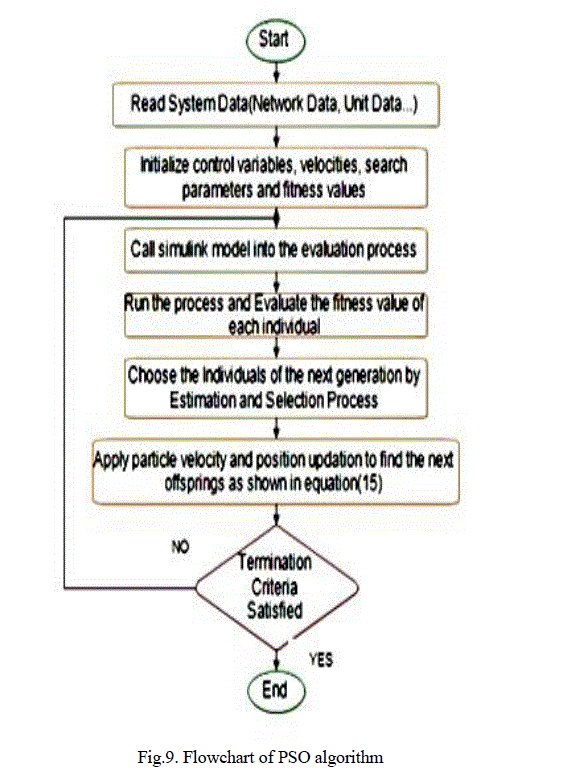 |
V. SIMULATION REULTS |
| This section describes the comparision of total harmonic distortion (THD) of source current by employing shunt active power filter controlled by PI controller, ANN based PI controller and particle swarm optimization (PSO) based PI controller. The simulink model of the system is given below in fig.10. |
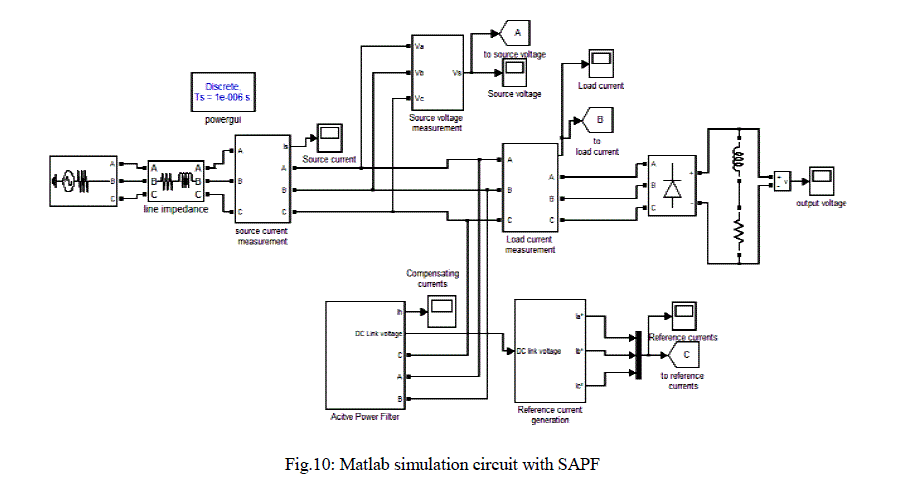 |
| The output waveforms of load harmonic current, harmonic compensation current and resultant source current waveforms of conventional PI controller is shown in fig.11 and DC Link voltage of Shunt Active power (SAPF) filter for PI, PI-ANN and PI-PSO is shown in fig.12. |
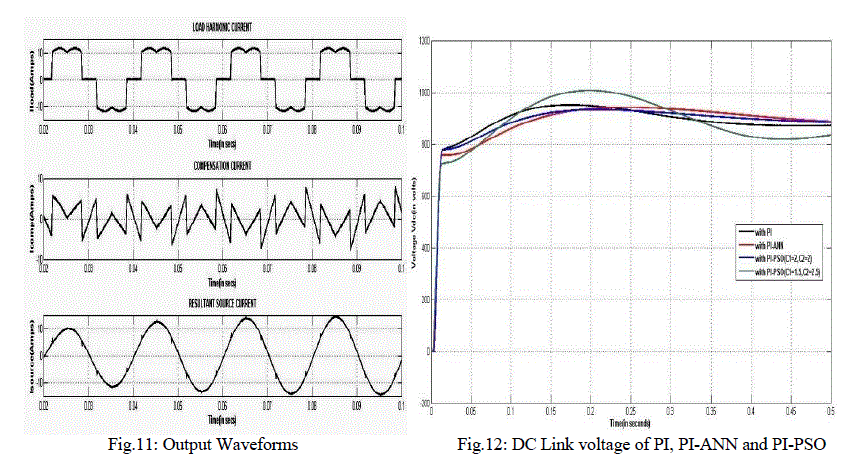 |
| THD convergence illustration of PI-PSO algorithm and THD analysis of source current in bar graph representation are shown in fig13 and fig.14 respectively. |
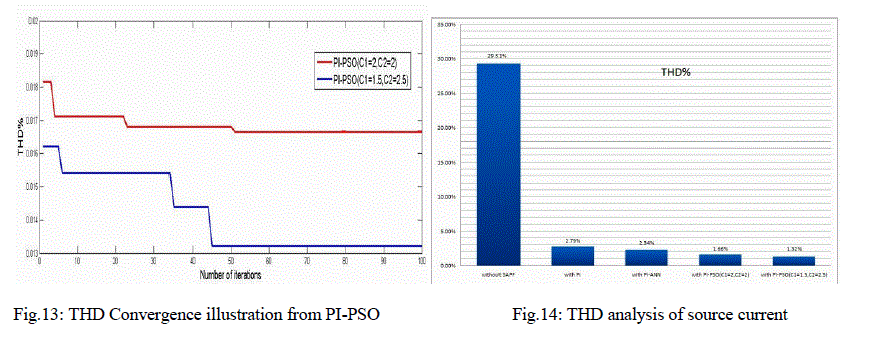 |
| In Table.1 source current THD is given for different controllers and design parameters of system model are given in Table.2. |
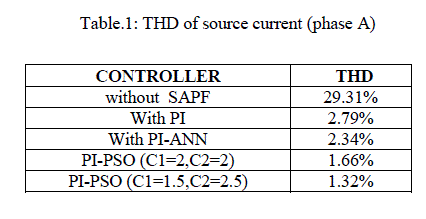 |
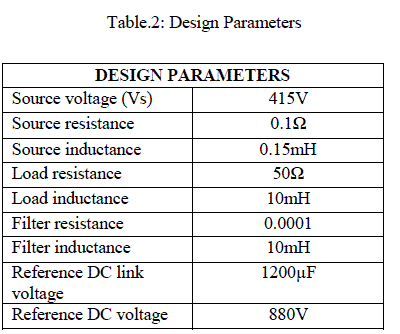 |
| Without SAPF the illustration of THD of source current (phase A) is 29.31% . With conventional PI controller based SAPF, THD of source current is reduced to 2.79%. it can be analysed from the fig.15.the THD of source current is further reduced to 2.34% by using ANN based PI controller SAPF to maintain the capacitor voltage is equal to the reference voltage .With PI-PSO optimized controller the illustration of THD in source current which is reduced to 1.66% with acceleration constants C1=2, C2=2 and 1.32% with C1=1.5, C2=2.5 by making Kp and Ki ranging from (0,200).The Convergence of THD is shown in Fig.13. The PI-PSO optimization has been run for 100 iterations considering 10 populations with 20 divisions each. |
VI.CONCLUSION |
| In this paper real and reactive power (P-Q) theory is used to generate reference currents to control SAPF which is used to compensate reactive power and harmonic currents with different types of controllers. At this level, comparative studies between the conventional PI controller, ANN based PI controller and Particle Swarm Optimization (PSO) based PI showed that Particle Swarm Optimization has been proved to be better in terms of harmonic reduction in source current and compensating the reactive power. The dc bus voltage has been maintained constant equal to the reference voltage by all PI,ANN based PI and PSO based PI. It has been found that these robust and nonlinear controllers prove to be better than conventional controllers. |
References |
|